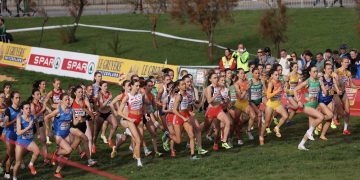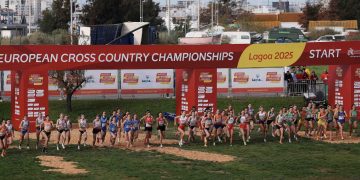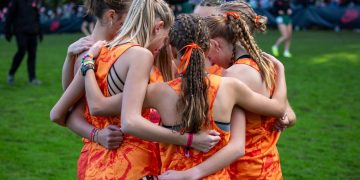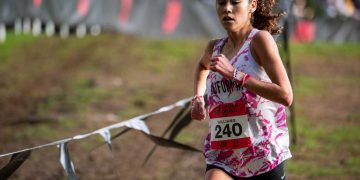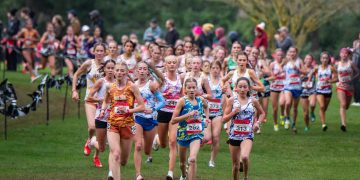This is part two of David Hunter’s feature on Clayton Murphy’s ecstacy then agony. It is a piece for all coaches and athletes to read. There are times that the best laid plans do not work out.
How do you learn from them? How do you get back on the proverbial horse? That is the question.
Clayton Murphy provides some thoughts on where 2018-20 are going. It should be exciting.
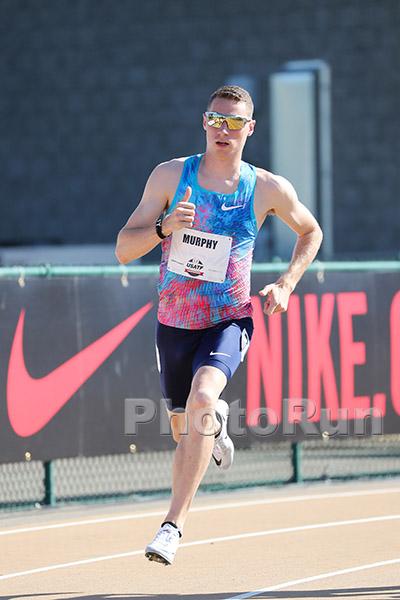 Clayton Murphy, photo by PhotoRun.net
Clayton Murphy, photo by PhotoRun.net
This is the second part of a two-part series on the topsy-turvy 2017
of America’s Olympic 800 meter bronze medalist.
October 8th, 2017
“Life is what happens to you while you’re planning on doing something else.” – John Lennon
As if Clayton Murphy’s self-imposed goal of earning a spot on Team USA’s World Championship team in both the 800 meters and the 1500 meters was not challenge enough, in the days leading up to the USATF outdoor track & field championships, Mother Nature intervened to deliver scorching temperatures, making Murphy’s Sacramento quest more daunting still. Even with an 11th hour scheduling change to evade the day’s heat peak, the mercury still registered 113 degrees as the first round of the 800 meters was announced. Normally perky middle distance racers were grim faced walking onto the track as if they were being led to the gallows. Peeling off his ice vest, Murphy was all business. Running a measured race requiring only a modest, yet decisive move over the final 150 meters, Murphy captured an automatic qualifier. Scurrying through the mixed zone, Murphy headed back to the hotel to rest, eat, and prepare for the first round of the 1500 some 4 hours hence. While the 1500 first round race was more strenuous than Murphy’s earlier 800 meters, he was up to the challenge and advanced by posting the fastest time qualifier of the day. Day One’s mission was accomplished. In the Day Two 800m semi with blistering temperatures still well above 100, Clayton once again looked sharp, snaring yet another auto qualifier for the closing day’s 800 meter final.
The Day Three 1500 meter final was a much-anticipated showdown between Clayton Murphy and the reigning Olympic 1500 meter champion Matthew Centrowitz. Run again under oppressive heat in the mid-90’s, the race unfolded as expected with the two favorites plus Ben Blankenship and Robby Andrews up near the front. “It started at 700 meters to go on the backstretch,” reflects Murphy. “I made a big move, not knowing that there was a group coming behind me. I went to the front. At 600 meters to go, I thought, ‘I’m in this. I’m going for the win. I feel good.’ With 500 meters to go, I still felt good. My legs were starting to tighten up a little, but nothing out of the normal.” But then the Olympic 800m bronze medalist began to unravel. “At 400 meters to go, there was another move made and I had to counter it. At that point, my hamstring started to grab. With 250 meters to go, I put one final move on and there was absolutely nothing left.” With the field speeding past him, Murphy was forced to make a tough decision. “At that point I had to shut it down because there was no way I could catch them. Everything had grabbed and was locked up.” A disconsolate Murphy jogged in the final half lap, finishing last.
Just like that, Murphy’s dynamic shifted. Once at the threshold of qualifying for the London championships in 2 events, Murphy now found himself scrambling to find a way of making it onto the world championship team. 4 tough races in 48 hours under withering heat had taken its toll. Could Murphy regroup for the 800 meter final – his specialty – the following day? “I did a full warmup. I did everything: I was wearing tights; I got stretched out before the race,” recounts Murphy on his race day efforts to get ready for the 800 meter final. “And 2 minutes before the call for the race, I did a few strides not anywhere near 100%. And I knew I needed to know if I could start the race or not. And so I did a start the way I would start the 800 and I made it about 50 meters and then I ran right off the track because I couldn’t make the turn because my legs were locked up and tight,” he recalls. “I scratched one minute before last call.” Not only was the ambitious 2-event dream gone, a position of any sort on the Team USA world championship squad had slipped away as well.
In the wake of the disappointment of Sacramento, Clayton and Coach Labadie first focused on a singular thought: Get back on that pony. “We actually initially thought right after it happened about going to London and racing right away – with a one-weekend recovery and then get back at it,” reveals Murphy. “But it [the hamstring problem] ended up lingering even more.” More rest and therapy did not seem to speed up the recovery process. “When I finally got back to what I thought was full strength, I did a workout and came back the next day and couldn’t run again. So I ended up having to pull out of Monaco and Rabat. At that point, I ended up pulling out of 3 meets in a row being unable to go 100%.” The hamstring situation confounded the athlete, the coach, and those who treated it. “There never was a season-ending injury. But there was a lingering injury of the hamstring to some degree. There was never a formal analysis of my hamstring. And it never felt 100%.” Perplexed by the extended recovery time apparently needed, Murphy and Labadie adopted a cautious approach. “To me, it was not worth risking a more serious hamstring injury through racing at that point. About 2 weeks after USA’s we started to approach what I thought was 100%. So we were trying to do some stuff right before Worlds, but obviously everybody else was getting ready for Worlds so there was not much going on. At that point we just focused on making sure I was 100% and ready to go. I had a few other minor setbacks – little things that would pop up and would inhibit doing a workout for a day or two.” After a lackluster race in Sopot, Poland revealed Murphy’s lack of race readiness, the decision was made to shut it down. “”The [Sopot] race went well for 600-700 meters and then my fitness just wasn’t there,” explains Murphy on his last place finish. After USA’s, I was never able to put together a 2-3 week stretch where I was clicking off miles and workouts.” Clayton Murphy’s 2017 outdoor season was over.
Speculation sprouted after Murphy’s Sacramento disaster. Was his newly-emerging romance with Oregon sprinter Arianna Washington a critical distraction? “No,” Murphy flatly declares. “That was about the best thing that came out of this was to go through that tough time with some of the best, to keep me going.” Are Murphy and Washington – who captured a gold medal in London as a member of the USA women’s victorious 4×100 meter relay team – still an item? “Yes, it’s going really good actually.”
Upon his return to the States, the #3 800 meter runner on America’s all-time list finalized his west coast relocation plans that began quietly earlier this year. “In the spring, I brought it up. I thought there were so many possibilities and benefits to being there,” explains the New Paris, Ohio native about a possible move to Oregon. “There was nothing bad about being in the training environment I had [at the University of Akron]. But I thought there were a lot more opportunities and possibilities to continue to get better. I looked at it going forward. I looked at my 2016 season. Everything was structured to fit me as a collegiate athlete. I wanted to bring all of the resources together to make what I needed to be the best I could possibly be.”
After considering several west coast locations and a few of the premier elite track & field training groups, the young Olympic medalist knew the fit he wanted. “The Nike Oregon Project takes all those pieces [necessary to be a successful professional track & field athlete] and puts them in a little pile for you. And all you have to do is pull out of the pile any pieces you want [body work massages; medical analysis; etc.] Everything is exactly where you need it to be and exactly made for you to be the best possible competitor you can be.”
The professional and welcoming approach NOP leadership exhibited to Murphy’s potential realignment affirmed for the former Zip star that he was making the right move. “I was welcomed with open arms. They never stepped on any toes; they never forced; they never asked me to join early. When I came with the idea in the spring, I brought it to John Capriotti and Alberto [Salazar] after I talked to Coach Labadie about it. I mentioned that I didn’t want to make any transition until the end of the year. But I wanted them to know that this was a transition I was thinking about. Their reaction was that if I ever wanted to talk further about this transition, they were available. ”
Affiliation with the Nike Oregon Project will not only align Murphy with the highly successful – and often provocative – Salazar to guide his fortunes. The move will also afford him regular training sessions with the likes of Centrowitz, Galen Rupp, and others – highly-talented and accomplished athletes who can help Murphy reach his maximum potential. How Murphy and Centrowitz can transform their competitive rivalry into a mutually-beneficial relationship between middle distance training partners is yet to be established. “We haven’t really got to that point yet. [Because of my injury and being overseas] there hasn’t been that much interaction between me and Matthew, the team, or the details of relationships with team members. How the team aspect is going to work, there are some details still to be worked out.” Salazar’s success in cultivating compatibility, even a genuine friendship, between NOP teammates Rupp and Mo Farah is encouraging evidence that Centro and Murphy can make this transformation work.
The special relationship shared by Clayton and Coach Labadie could have been strained or even irreparably damaged in such a transition. To their credit, both individuals worked hard to make sure their special bond was not bruised in the process. “Coach Labadie is more than a coach to me. Whether he is my coach or not, he is one of the first people I would have told anyways,” Murphy reveals. “Our relationship is exactly the same. Just less workout-type messages now. Our relationship never bent or pulled away during the season. It never felt like it was strained at all. We communicated via text messages daily. I sent logs to him at night. We had daily phone conversations. [The transition] didn’t change our relationship.”
With past inquiries about his race focus on the 800 meters or the 1500 meters, Murphy’s replies had often been coy. Yet now, the 800m bronze medalist is more revealing. “I don’t think I’ve ever ignored the 1500, but I think there will be a lot more focus on the 800. When I look back on all of the training I’ve done and what’s worked, I see a lot of potential with what I am doing for the 800 that can aid me in the 1500. So when the opportunity comes around to run a fast 1500, I’m going to run a fast 1500 because I love that event and I can account for it. And I have goals set for the 1500.” And a serious effort at the longer distance might not be that far away. “By no means am I ever going to say I’ll never run a 1500 for the next year or so. It’s going to be when the next opportunity comes with the right race, the right time in the season, and with the right training. And I’m going to get after it and try to see if a record is possible in the 1500.” But Murphy affirms that his primary focus will be on the two-lap event. “In the 8, it is going to be a focus to chase the American record in the 800 and keep it on the radar for 2018, ’19, and ’20 coming up. Whether I stay after the 15, who knows? It’s years out. But right now, I’ll focus on the 800.”
Murphy’s 2017 goals may not have been fully achieved. But the young middle distance ace has already formulated specific 2018 goals – and plans to achieve them. “The first step is World Indoors,” offered the young half miler with enthusiasm. “I’m gearing up for it. I started my training for it last week [the beginning of October]. That’s my focus right now.” Captured from 2017, Clayton has adopted the Dalai Lama’s approach: if you lose, don’t lose the lesson. “If I took anything from last season it’s one season, one race, one week, one day at a time. So right now I’m planning a big picture goal for 2018 to have a world championship.” With this ambitious goal, Murphy knows everything else must contribute toward the targeted achievement. “It is hard to know what’s going to go down. For right now, I only have an idea what I am running prior to Birmingham. Right now it is – right or wrong – the 800 in Birmingham and I am going to do whatever it takes between now and then to be on the podium in Birmingham.”
Lennon’s quote – a sardonic reminder of life’s unpredictability – underscores the importance of resiliency in the face of life’s unexpected developments. Most people can easily be gracious when life has them sailing along on Plan A. The real test of one’s character is how a person responds when life presents them with Plan B, or C, or D, or Q. Murphy passed the test when he handled this year’s misfortunes with grace and poise. And now he is ready to face the next challenge: getting back to Plan A in 2018.
Author
-
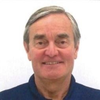
Dave Hunter is an award-winning journalist who is a U.S. Correspondent for Track & Field News. He also writes a weekly column and serves as Senior Writer for www.RunBlogRun.com, and covers championship track & field competition domestically and in such global capitals as Moscow, Birmingham, Zurich, Brussels, Beijing, Rio de Janeiro, Zagreb, Ostrava, and Doha. Hunter frequently serves as the arena or stadium announcer for championship track & field gatherings, including the Ivy League, the Big East, the Mid-American Conference, the NAIA, the Big Ten, and the Millrose Games. Hunter has undertaken foreign and domestic broadcast assignments. He ran his marathon P.R. 2:31:40 on the Boston Marathon course back in the Paleozoic Era. To find out more about Dave, visit his website: www.trackandfieldhunter.com He can be reached at: [email protected]
View all posts


